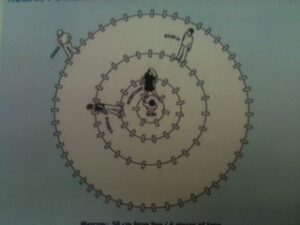I Like the Way You Move

Author(s): Sarah Sue
Subject: Earth Science
Grade Level(s): Grade 3
Big Idea(s): Earth is one of several planets that orbit the Sun and that the moon orbits the Earth. Objects in the sky move in regular and predictable patterns.
What you need: clipboards, rubber balls in various colors to represent the Sun, Moon, Mercury, Venus, Earth, and Mars, student science notebooks, tape and “I Like the Way You Move” Lab Sheets
Setting: Five students are chosen to represent Mercury, Venus, Earth, Mars, and the Sun. The rest of the class sits in a circle around “Space Objects,” and record observations in science notebooks. This lesson requires a great deal of space and is best when taught on a stage, gymnasium, or playground.
Time Needed: Approximately 45 minutes
Summary:
Students complete this lesson in order to gain understanding of the actual movements of the planets around the Sun.
Learning Goals / Objectives:
Students know how the planets move through space. Students know how and why each planet takes a certain length of time to orbit the Sun.
Background
This lesson is one within a unit titled “The Sun and Its Planets.” Within the unit students have the opportunity to use solar viewing glasses, and participate in various activities that explain why planets shine and differentiation between direction (ie. east and west).
Setup:
The picture above depicts the setup for this lesson. This idea was developed for the NASA Kepler Mission, a space-based telescope/camera looking for Earth-like planets around other stars. The illustration is adapted from a Lawrence Hall of Science GEMS curriculum.
Mercury: 58 cm from Sun/6 pieces of tape
Venus: 108 cm from Sun/16 pieces of tape
Earth: 150 cm from Sun/26 pieces of tape
Mars: 228 cm from Sun/50 pieces of tape
Place duct tape tabs on the floor for each planet. Pick volunteers to be the four planets. Start the simulation with the planets in a straight line out from the Sun. Everyone starts chanting in unison, “Two weeks, two weeks, two weeks…..” These are the scaled distances of movement between duct tape strips. The “planets” take one step every time the students chant “two weeks.” You can actually view the apparent “retrograde motion” of Mars as seen from Earth that deceived earlier astronomers.
Anticipatory Set:
We live on planet Earth. Earth is just one member in a family of eight major planets. All of these planets orbit the Sun, which is the star at the center of the solar system. The Sun shines because it produces its own light, and this radiation from the Sun gives Earth the light and warmth needed for life. Some of the planets have moons that orbit around their parent planet. The Sun’s gravity holds the planets in their orbits. From Earth we view the solar system “from the inside out,” so its structure is not easy to figure out by just looking at it.
Instructions / Activities:
1. Students brainstorm what they know about Mercury, Venus, Earth, Mars, and the Sun on a sticky note and place it on a corresponding poster.
2. Student volunteers are chosen to represent Mercury, Venus, Earth, Mars, and the Sun. Each student will hold a rubber ball labeled with the name of the solar system
object he/she is representing.
3. In an open area, the student representing the Sun, stands in the center of a pre-taped and labeled circle, on the spot marked “Sun.”
4. Students start the simulation with the planets in a straight line out from the Sun. Observing students chant in unison, “Two weeks, two weeks, two weeks,…” as the
volunteers follow their pre-taped orbit path, taking one step with every “two week” chant.
5. As this is happening, remaining students sit in a circle and fill in the observation section of their “I Like the Way You Move” Lab Sheets, sketching and labeling the
location of the planets.
6. Teacher explains the ideas of orbit, rotate, axis, and revolution and how each are represented in the simulation.
7. At the close of the lesson, they will make a claim using the new vocabulary on another sticky note by answering the following question: Can you explain how the planets
move through space? (teacher will distribute)
Assessment:
Exit Ticket: Can you explain how the planets move through space and around the Sun? Students show mastery of this outcome through the use of science notebooks, classroom discussion, and ability to defend their thoughts through partner pair/share and cooperative group work.
Wrap-up / Closure:
Students pair/share their answers to exit ticket question and demonstrate their ability to defend their ideas.
Tags: Grade 3
Categories: Earth Science

